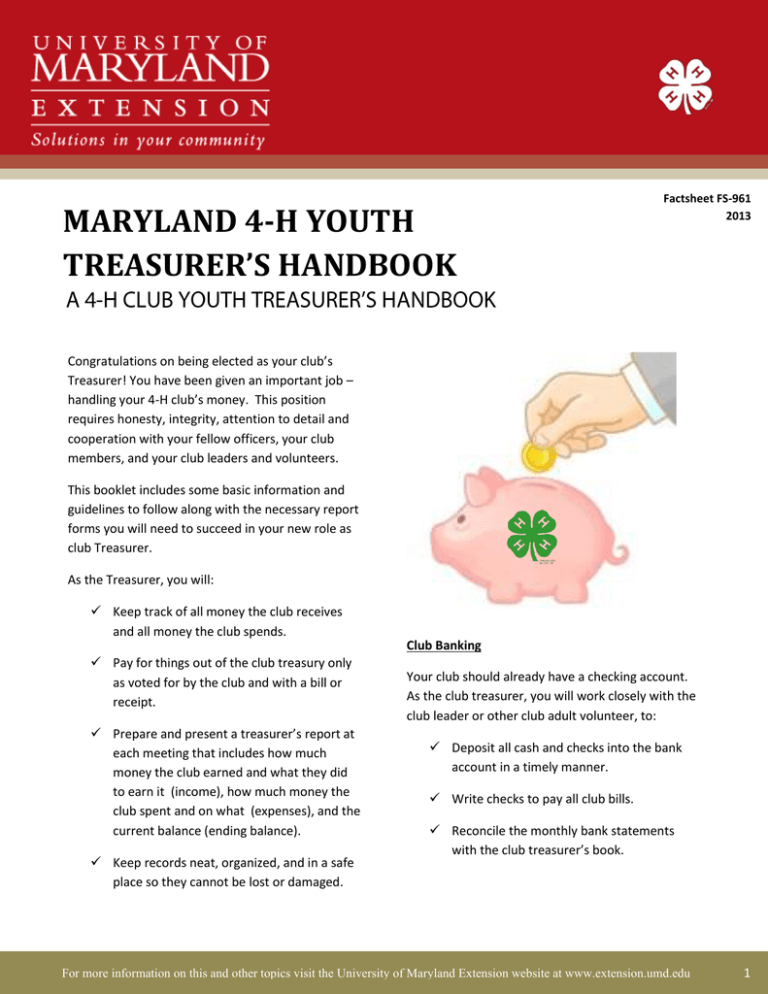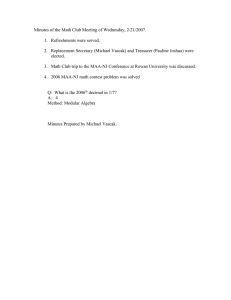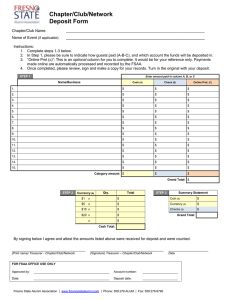MARYLAND 4-H YOUTH TREASURER’S HANDBOOK
advertisement

MARYLAND 4-H YOUTH TREASURER’S HANDBOOK Factsheet FS-961 2013 Congratulations on being elected as your club’s Treasurer! You have been given an important job – handling your 4-H club’s money. This position requires honesty, integrity, attention to detail and cooperation with your fellow officers, your club members, and your club leaders and volunteers. This booklet includes some basic information and guidelines to follow along with the necessary report forms you will need to succeed in your new role as club Treasurer. As the Treasurer, you will: Keep track of all money the club receives and all money the club spends. Club Banking Pay for things out of the club treasury only as voted for by the club and with a bill or receipt. Prepare and present a treasurer’s report at each meeting that includes how much money the club earned and what they did to earn it (income), how much money the club spent and on what (expenses), and the current balance (ending balance). Keep records neat, organized, and in a safe place so they cannot be lost or damaged. Your club should already have a checking account. As the club treasurer, you will work closely with the club leader or other club adult volunteer, to: Deposit all cash and checks into the bank account in a timely manner. Write checks to pay all club bills. Reconcile the monthly bank statements with the club treasurer’s book. For more information on this and other topics visit the University of Maryland Extension website at www.extension.umd.edu 1 Let’s practice a few tasks you will have to do as club treasurer, like writing a check, balancing a checkbook, and writing your club treasurer report. Receiving Money (Income) When you receive money from a fundraiser or a donation, you need to write a receipt for it. A receipt is proof that your club received the specific amount of money and that you handled it correctly. Figure A below will show you what information you need to put on the receipt. Figure A: Sample Receipt June 24, 2012 15.00 Carl Clover Fifteen dollars ---- oo/100 Hoagie Sale 15 00 0 00 Carl Clover Four Leaf 4-H Jimmy Green, Treas. Your club should have a receipt book with pre numbered carbon copy receipts. (They are available from any office supply store.) If you make a mistake and have to void a receipt for any reason, mark “VOID”, and keep them with the Treasurer’s record. Then begin a new receipt. Bank Deposits When you receive any income, you will need to deposit it into the club’s bank account. This could be cash, coins, or checks. Before you deposit a check, the person to whom it is payable must endorse (sign) the back of it. Checks that are made payable to the group must be endorsed by signing the group name (as written on the check) and the Treasurer’s name. After you sign the check, write “for Deposit Only” on it, so that if it was lost or stolen, it cannot be cashed. Total the dollar amounts of the receipts you have written since you made the last deposit. Then compare that amount with the amount of cash, coins and checks you intend to deposit. The two figures should match. If they don’t, recount the amounts again. When the two figures do match, prepare a deposit slip similar to Figure B. For more information on this and other topics visit the University of Maryland Extension website at www.extension.umd.edu 2 There may be a supply of deposit slips at the end of each pad of checks. Or you could pick up a slip in the bank lobby. Figure B: Sample Deposit Slip 5. Make a copy of the deposit slip and keep it with the bank receipt. $ Tip Follow these steps when filling out a deposit slip. Deposit all funds promptly, ideally within seven days or less. 1. Date the deposit slip. 2. Fill in the amount of currency (bills) and coins you are depositing. 3. List each check number and its amount separately using the back of the slip if necessary. Checks that are made payable to the club must be endorsed by signing the club name and your name. 4. Record the deposit in the checking account register. For more information on this and other topics visit the University of Maryland Extension website at www.extension.umd.edu 3 Now it’s time to record the deposit in your check register similar to Figure C. Include the date, description of the deposit, and the amount. Figure C: Sample Check Register Entry 6/30/12 Balance Ck#9578 7/8/12 To: Dollar General 561 21 6 82 For: Paints for Fair Booth - 6 82 554 39 Approving and Paying Bills Part of your treasurer’s report is asking for, and receiving, the approval of club members to pay outstanding bills. After the members approve paying the bills, write a check for the approved amount for each bill. The BEST way to pay bills is with a check. Holding cash back from deposits and then using the cash to pay bills is NOT a good practice because it doesn’t leave a record or provide proof of payment and should not be done. A proper receipt protects your reputation as treasurer. A simple way to remember what you need to record when you are paying for anything is to remember the “5 W’s:” 1. Who did I pay? 2. What is the amount? 3. When did I pay it? 4. Why did I pay it? 5. Where did the money come from? (which account, checking or saving?) Writing Checks Part of your work as the Treasurer will be to write checks to pay the outstanding bills. Every time you write a check for the club, you must also record it in the check register. You also must have a receipt or bill from the For more information on this and other topics visit the University of Maryland Extension website at www.extension.umd.edu 4 person you are paying in order to write a check. Be sure not to write a check if the club doesn’t have money in the checking account to cover it. Lastly, always have the club leader or another approved adult sign the check with you. Figure D: Sample Check 6/28/12 Oriental Traders 18.52 Eighteen Dollars ----------------------------------------------------52/100 4-H Balloons Karley Hanshaw, Treas. Gloria Long, Leader 1. Write today’s date on the check. 2. Start writing the name of the person or business to whom the check is payable as close to the “Pay to the order of” as possible. $ Tip Always Use Ink – Blue or Black is Best Never Erase a Mistake - Write Void and start a new one 3. Leave as little space between the figures and words when filling in the amount lines. This helps prevent someone else from changing a $1 check, into a $100 check. 4. Begin writing the amount at the extreme left of the amount line. Be sure the written amount agrees with the numeric amount. 5. Sign the check with your authorized signature, the same way you signed the signature card at the bank when you became treasurer. Then also have the club leader sign, or other authorized adult. Your completed check should look similar to Figure D. Maintaining the Check Register It is always important to keep your club’s check register up to date at all times. In order to maintain the club’s check register: 1. Write the check number and the date it was written in the appropriate column. 2. In the “Description of Transaction” column, write to whom the check was written to. For more information on this and other topics visit the University of Maryland Extension website at www.extension.umd.edu 5 3. Enter the check amount in the “payment/debit” column and in the balance column. Then subtract the check amount from the remaining balance on the line above and enter the new balance immediately below. statement. Use this space to check off the checks that have cleared the bank. This information is on your monthly bank statement, which we will get to later. 5. Record the amount of any deposits in the “deposit/credit” column. Then add the deposit account to the account balance on the line above and record the new account balance straight across. Figure E: Sample Check Register Maintenance 6/30/12 Balance Ck#9578 7/8/12 To: Dollar General 561 21 6 82 For: Paints for Fair Booth Ck#9579 7/19/12 To: Family Dollar 554 39 9 67 - 9 For: Socks for sock puppet craft 7/31/12 Deposit - 9 67 From: Fair premium from Booth - 6 82 67 544 72 + 15 00 559 72 Reconcile the Bank Statement The bank will mail a statement every month with the current balance of the club account to your club leader. You need to go through your records for the month and make sure that your records match with the banks records. This is called “reconciling your bank statement.” 1. The statement will show all the checks and deposits that have “cleared” for the month. A check is cleared once the bank has received, recorded, and charged your account for it. If you write checks all month, it is possible you will not see all your issued checks on this statement. As part of the reconciliation, you will need to make a record of these “outstanding” checks, that is, checks that have not yet cleared. Compare each item in the bank statement to your check register. Make sure that the amount of your check matches what the bank charged. Make a check mark in the register in the space marked to show that you have verified that the two amounts match. 2. Compare each deposit, and make sure your register and the bank statement match. 3. If the bank charged you for any fees, write the fee into your register and subtract the fee from your balance. For more information on this and other topics visit the University of Maryland Extension website at www.extension.umd.edu 6 4. Look at your check register. You should now have all the checks and deposits, checked off and, perhaps, some you did not because they have not cleared the bank. Figure F: Bank Reconciliation 5 8 Ck#9579 Family Dollar - 9.67 9 5 6 - 9.67 569 39 0 00 6 7 569 39 8 9 10 - 9 67 559 72 5. List the checks and deposits that have not cleared and total. 6. Write down the ending balance shown on the front of the bank statement. 7. Add your deposits that have not cleared to the balance. 8. Total outstanding deposits. 4 9. Subtract the total of outstanding checks. 4 balance. If the balance is different, you need to first 10. The difference should match your bank register go back and check your math. If you still have a difference that you cannot figure out, call your bank and ask them for help. Also talk to your 4-H club leader for help. When you have completed the reconciliation, have another 4-H adult volunteer check your work for accuracy. Difference - $9.67 Check Book Balance - $559.72 Bank Statement Balance - $569.39 Completing the Monthly 4-H Club Treasurer’s Report Form The Treasurer’s report informs members of the group’s financial activity for the past month. Whenever you pay for something or receive money for the club, you write it down in the check register, but you also need to record it on the Club Treasurer’s Report. After the group has heard your treasurer’s report, a member moves to accept the treasurer’s report, the motion is seconded and the club will vote to accept or reject the report and you have permission to pay the bills. For more information on this and other topics visit the University of Maryland Extension website at www.extension.umd.edu 7 To complete the report form, you should: Record everything you have entered in the check register. Total the expenses and total the income. Then total the balance at the bottom. Go back and double check to be sure you recorded every transaction. A sample monthly treasurer’s report can be found in Figure E. Figure E: Sample Monthly Treasurer’s Report 4-H Clever Clovers Monthly Treasurer’s Report March 21, 2012 1. (State the beginning balance, which is the ending balance from the meeting before) The beginning balance was $277.63. 2. (Indicate the money source, reason, and amount received) We received a donation from the Lion’s Club for $20.00 for club activity supplies. We earned $89.54 from our bake sale to help purchase t-shirts for the club. So our total income was $109.54. 3. (Indicate the reason, amount, and payable to) We had an expense of $18.62 for 4-H Balloons paid to Oriental Traders. We also made our annual donation of $50.00 to the Bernville Fire Department for letting us meeting in their building. So our total expenses equaled $68.62. 4. (Calculate the balance including bank reconciliation) There are no outstanding checks or deposits. Our ending balance is $318.55. Fundraising All fundraising activities must be approved by the local UME 4-H office (forms can be found at your local UME office or on the Maryland 4-H website). Be sure to raise money only for specific educational purposes. Don’t let the habit of fundraising become so important that it gets in the way of learning and doing. For more information on this and other topics visit the University of Maryland Extension website at www.extension.umd.edu 8 Finishing the 4-H Year Financially There are several reports that will need to be completed at the end of each 4-H year. These forms are due to your county/city 4-H office October 15th. Annual Financial Summary Report Annual Inventory Report Club Treasurer’s Book These annual reports fulfill several needs. It creates an open, public record of each non-profit group receiving public donations and paying sales tax, and it also fulfills the audit concerns of the University and federal requirements for financial accounting by 4-H groups. This report is how 4-H fulfills its obligations of fiscal accountability to the residents of Maryland. File the Club’s Tax Return All clubs have to annually file a 990 or 990-N (e-Postcard) with the IRS. You and the Club Leader or another approved adult should prepare the return together, by November 15th. More information on how to do this can be found at the local UME 4-H office or on the Maryland 4-H website. This publication, MARYLAND 4-H YOUTH TREASURER’S HANDBOOK (FS-961), is a series of publications of the University of Maryland Extension. The information presented has met UME peer review standards, including internal and external technical review. Please visit http://extension.umd.edu/ to find out more about Extension programs in Maryland. The University of Maryland Extension programs are open to any person and will not discriminate against anyone because of race, age, sex, color, sexual orientation, physical or mental disability, religion, ancestry, national origin, marital status, genetic information, political affiliation, and gender identity or expression. For more information on this and other topics visit the University of Maryland Extension website at www.extension.umd.edu 9


